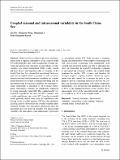Coupled seasonal and intraseasonal variability in the South China Sea
Author(s)
Wang, Dongxiao; Li, Mingting; Wei, Jun; Rizzoli, Paola M
Download382_2014_Article_2250.pdf (1.297Mb)
OPEN_ACCESS_POLICY
Open Access Policy
Creative Commons Attribution-Noncommercial-Share Alike
Terms of use
Metadata
Show full item recordAbstract
Based on 10 year climatological data and simulations from a regional atmosphere–ocean coupled model (FVCOM-RegCM3), this study examined the coupled seasonal and intraseasonal variability of atmospheric–oceanic variables [sea surface temperature (SST), winds, rainfall and heat fluxes] and important roles of coupling in the South China Sea. It is showed that even though both coupled and uncoupled models in general are able to capture observed seasonal and intraseasonal variability, the coupled model demonstrates stronger coupling relationship than the uncoupled model. For seasonal variability, the atmosphere–ocean relationship is presented as SST forcing atmosphere. Atmospheric variables are significantly influenced by strong seasonally-varied SST. The coupled model very accurately reproduced the observed SST variation with a stable equilibrium state, while SST from the uncoupled model gradually drifted away from the equilibrium state lacking of the so-called negative SST-heat flux feedback. Lead-lag analysis showed that the coupled variables demonstrated stronger SST-atmosphere relationship than the uncoupled and even observed variables. For intraseasonal variability, the atmosphere–ocean relationship is presented as atmosphere forcing SST. Wind becomes a dominant forcing and demonstrates robust negative relationship with SST and positive relationship with rainfall/LHF. Both coupled and uncoupled models are able to reproduce this observed relationship. In wind-SST relationship, compared to uncoupled and observed variables, the coupled model produced the smallest SST variances and therefore the strongest negative coupling feedback. Sensitivity experiments were also carried out to examine the roles of coupling by directly comparing differences between the coupled and uncoupled experiments with initial temperature perturbations. It is showed that the differences can be up to 50 % of the standard deviations of the variables. Root-mean-square errors of the uncoupled model can be effectively reduced by ~65 % in the coupled model.
Date issued
2014-07Department
Massachusetts Institute of Technology. Department of Earth and Planetary Sciences; Singapore-MIT Alliance in Research and Technology (SMART)Journal
Climate Dynamics
Publisher
Springer Berlin Heidelberg
Citation
Wei, Jun et al. “Coupled Seasonal and Intraseasonal Variability in the South China Sea.” Climate Dynamics 44.9–10 (2015): 2463–2477.
Version: Author's final manuscript
ISSN
0930-7575
1432-0894